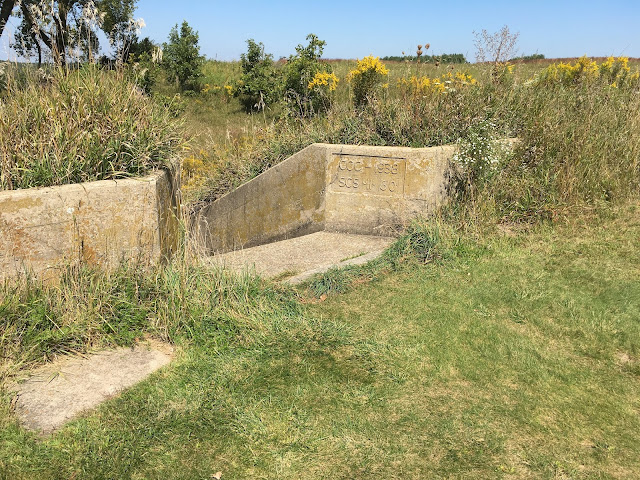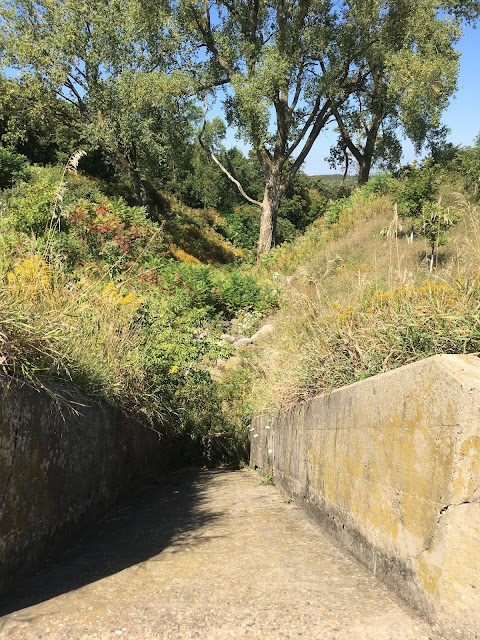The first seventeen entries in my ongoing series of posts about the stonework of the Civilian Conservation Corps featured structures situated in state and national parks - bridges, ramparts, towers, stairways and other substantial achievements. Stonework of that type has been well preserved because of the locations and ongoing usefulness of the structures.
But the boys in the CCC also did an immense amount of work in fire prevention (fire breaks, lookout towers), reforestation, water control (dams, reservoirs) and soil conservation. The structure in the photo above is one of probably thousands of such water/soil conservation measures that have been generally forgotten (and in most cases left to fall into disrepair).
I encountered this stonework while hiking at the Pope Farm Conservancy, a working farm with restored natural areas located in the western suburbs of Madison, Wisconsin. I had visited there last year to photograph and blog the remarkable display of sunflowers.
On my recent visit I explored a different part of the property, where hiking trails had been carved out of restored short-grass prairie:
Without a panorama image it's hard to depict the rolling contour in this area created by deposition of sand during the terminal phase of the last glaciation. The hill in front of me (above) is a recessional moraine. To the right of the photo the land slopes downward, then back up again to a broad "bowl" currently covered by cropland and native prairie.
Prior to the arrival of European immigrants, a basin like this would have been covered with either long grasses or short grasses -
Prairie grasses evolved immense root systems that enabled them to regrow after intensive grazing by massive herds of bison, or after wildfires or drought. What they couldn't survive was the introduction of intensive farming, and especially the cutting power of steam- or gasoline-powered tractors. I don't need to repeat here the familiar sequence of stripping vegetation to plant crops, followed by topsoil erosion by wind and water.
By the 1930s a basin such as the one above would have been deeply gullied by rainwater and snowmelt and the runoff would have been choking local streams with sediment. Teams of CCC boys were mobilized to correct these problems on a farm-by-farm basis.
All you see now at the base of the "bowl" is this concrete structure:
This is a simple, but perfectly adequate spillway.
"This dam design, called a head flume, was suggested by UW-Madison soils and agriculture professor Otto Zeasman. It was simple because the intent was merely to slow the flow of water during times of heavy rain and runoff."To the left and right of the downsloping segment are short concrete walls and then earthen berns, which direct water to the center:
The chute prevents ground erosion as it conducts the water down the steepest part of the slope. At the base of the chute (hard to see with summer vegetation overgrowth) is a triangular concrete "velocity check" structure, and behind that a pile of large boulders in the "stilling basin":
These components of the spillway absorb the kinetic energy of the falling water, which then proceeds down the ravine in the background with much less erosive force (cutting the velocity in half reduces erosion by a factor of 64 according to the information on a local informational placard). Another placard notes:
"Construction of the dam began in late summer 1938. A CCC crew of about a dozen young men needed about 2-3 weeks to finish the project. Other "soil saving" dams of the Great Depression era are quietly deteriorating in farm fields all over Wisconsin. Still others have been removed. This structure on the Pope Farm Conservancy site is the only one in south-central Wisconsin (and perhaps the entire state) that is being protected as an historic landmark."Kudos to the Pope Farm Conservancy for their stewardship of the land and the preservation of this example of a simple structure that helped rural farms recover from the devastating effects of the Great Depression and the Dustbowl.







Thanks to FDR for the intelligent use of surplus workers in a positive and helpful manner -- good for the country and good for the farmer! And thanks to you for noticing and informing us that these structures still exist throughout the country... Would that our current administration would notice the need for rebuilding of the infrastructure to employ the unemployed and to boost the economy.
ReplyDeleteI have been a faithful reader of your blog for some time, and really enjoy the CCC posts. I can't recall though, having seen a post about two of the most beautiful (IMHO) of all CCC works, stone and otherwise: the stone work along the Historic Columbia River Highway and its many waterfalls, and The Mount Hood Lodge both here in Oregon. If you aren't already familiar there are lots of good pics all over the interwebs. Thanks for all the good work
ReplyDeleteI'm sure those must be fantastic sites, but I haven't attempted to write up any CCC projects that I didn't personally visit and photograph. There were quite a few that were visited and photographed by readers of this blog, and I wrote up descriptions for them.
DeleteI do have family in Warrenton Oregon, so if I can come up with a plan to visit them, I'll try to make some relevant side-trips.